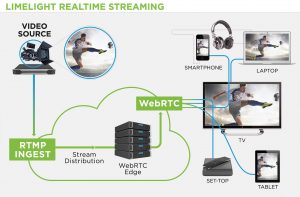Limelight Looks to the Future of Live Sports Streaming
Improved personalization and quality are seen for the rapidly growing industry
Story Highlights
Live sports streaming took off in 2018, but viewers still found plenty of issues holding it back. While viewers liked having easy access from any device, they didn’t like the quality concerns that often went along with it. Content-delivery network (CDN) Limelight’s year-end State of Online Video report examined both the growth and the issues.
First, a few stats. There’s huge interest in sports streaming, with 60% of consumers around the world saying they would watch sports online if the stream arrived at the same time as the broadcast feed. Limelight notes that sports is the fourth-most-watched type of content online. But live video still buffers, and viewers hate that: it’s the top annoyance for 43%. Also, two-thirds of viewers will abandon a feed after two rebuffers. The next most common problem is poor-quality video, cited as an annoyance by 32%.

Limelight’s Steve Miller-Jones says that, although 60% of global consumers say they watch live-streamed sports, buffering and latency remain a problem.
There was a lot to like in live sports streaming last year, says Steve Miller-Jones, VP, product strategy, Limelight. People streamed an enormous amount of World Cup and Olympics video and were happy with the events’ easy multiplatform accessibility.
But not all live streams went perfectly. When companies that aren’t primarily broadcasters live-stream events, they need to get production details right. Amazon failed at this during the US Open tennis tournament, according to Miller-Jones. Many viewers gave its coverage a one-star review. Streamers also need to be sure that promoted video is available for all viewers, he says, referring to Australian World Cup access problems. Meanwhile, rebuffering and latency still need to be improved.
Limelight’s Realtime Streaming solution is intended to solve latency issues with a WebRTC-based approach, rather than traditional HTTP.
“Limelight Realtime Streaming based on WebRTC is a sub-second–latency offering,” says Miller-Jones. “Rebuffering is very clearly a related issue. We see in our research that customers over the last three years are increasingly more frustrated with rebuffering and are increasingly more likely to try to find the stream somewhere else if it’s a persistent issue during their streaming experience. We know from our own service to the viewers as a CDN and our customers that that is an absolutely key metric used to derive the quality of experience that people are getting. And it’s a key metric used in the industry to understand who is performing well.”
Looking ahead, he sees big improvements coming to live streaming this year, mainly in the areas of personalization and quality. As viewers have access to more content, finding the material they really want to watch is a difficulty. Providers will need to offer stronger personalization services that surface the events a viewer is most interested in.
Before quality issues can be conquered, providers will need to decide the best method to pursue. Will HLS DASH win out or CMAF? And can sub-second latency be achieved while quality is maintained?

Workflow for Limelight’s Realtime Streaming solution, which uses a WebRTC-based approach to solve latency issues.
Says Miller-Jones, “There’s going to be a focus on quality and a requirement on CDNs like us to continue to invest in and innovate how we manage efficiency and how we maintain really good QoE for end users.”
Augmented reality (AR) is likely to play a big role in sports streaming this year. The UEFA experimented with digital billboards at some games last year, replacing the stadium’s digital signage in the OTT streams for various countries. That solution enables ads that are relevant in more than just the host country. Beyond advertising, AR can be used to add local data in each country’s stream, customizing the experience for fans.
Piracy is still a major concern, but Miller-Jones sees progress there as well. For rights owners, digital watermarking is clearly the technology to adopt, he believes. Last year, La Liga used watermarking to close down criminal groups’ rebroadcasting its streams. Watermarking lets the content owner manipulate the manifests on-the-fly, creating unique fingerprints for each user. When an illegally redistributed feed is found, the content owner can home in on the exact source. Used with digital-rights management (DRM), that should help ensure that all live-streamers deliver legitimate content to legitimate channels.
Viewers are enjoying greater access to their favorite sports. By this time next year, they should have an easier time finding and streaming games without interruptions, and content owners will be able to better monetize and protect their assets.
